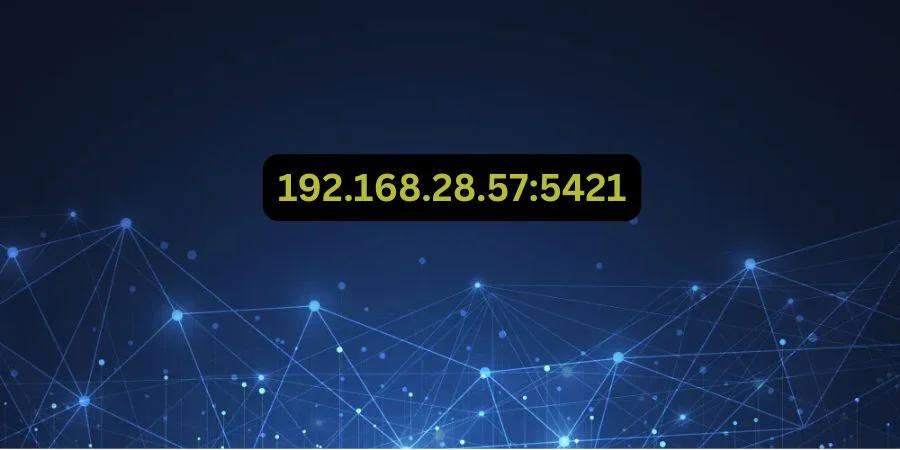Introduction to 192.168.28.57:5421
Navigating the world of network configurations can feel like exploring a maze, especially when it comes to understanding IP addresses and port settings. One such address that might catch your eye is 192.168.28.57:5421. This seemingly simple string holds significant importance in the realm of networking, particularly for those managing private networks.
Whether you’re setting up a home office or troubleshooting connectivity issues, grasping the ins and outs of this specific configuration can make all the difference. Let’s dive into what makes 192.168.28.57:5421 tick and why it’s essential for anyone looking to optimize their network experience!
What is a Private IP Address 192.168.28.57:5421?
A private IP address is a unique identifier assigned to devices within a local network. 192.168.28.57 falls into this category, allowing it to communicate internally without needing exposure to the wider internet.
This specific private IP belongs to the Class C range, which is commonly used in home and small office networks. It ensures that each device can interact seamlessly with others on the same network, such as printers, computers, or smart devices.
The appended port number 5421 further refines communication by specifying a particular service or application running on that device. This means data requests directed at 192.168.28.57 will be routed specifically through port 5421.
Understanding this configuration helps manage your local networking environment more effectively while maintaining security from external threats.
The Importance of Private IP Addresses
Private IP addresses play a crucial role in network management. They allow devices within a local network to communicate without exposing themselves directly to the internet. This creates an internal environment that enhances security.
By using private IPs, organizations can conserve valuable public IP address space. With the ever-growing number of devices connecting online, this conservation is vital for efficient resource use.
Additionally, private addresses offer better control over traffic flow and performance. Network administrators can manage bandwidth more effectively and implement policies tailored to specific needs.
Moreover, employing private addresses helps isolate sensitive data from potential external threats. It acts as a barrier between internal systems and outside vulnerabilities.
In essence, private IPs are fundamental components of modern networking strategies that prioritize both efficiency and security for all connected devices.
Understanding Port Configurations
Port configurations are essential for managing network traffic effectively. Each port acts as a communication endpoint, allowing devices to send and receive data seamlessly.
When you see 192.168.28.57:5421, the number after the colon indicates a specific port on that IP address. This setup is crucial for directing requests to the right service or application.
Understanding how ports work can help optimize your network performance. Different services use different ports; for example, web servers often utilize port 80 or 443 while gaming applications might rely on others altogether.
Misconfigured ports can lead to connection issues or security vulnerabilities. Therefore, knowing which ports are open or closed is vital in maintaining a robust network environment.
Always ensure that only necessary ports are accessible from outside networks to minimize risks associated with unauthorized access and potential exploits.
Common Uses for Private IP and Port Configurations
Private IP addresses and port configurations serve several essential functions in both home and business networks.
For instance, many routers assign private IPs to devices like printers and smart TVs. This setup allows seamless communication within the local network without exposing these devices to the public internet.
In corporate environments, private IPs are crucial for securing sensitive data. They help isolate internal systems from external threats while enabling smooth interactions among various departments.
Port configurations play a vital role as well. By managing which ports remain open or closed, businesses can enhance security measures against unauthorized access.
Gaming consoles frequently utilize specific ports to optimize online gaming experiences. Properly configured settings can reduce lag and improve connectivity between players.
Understanding how these components work together enhances network efficiency while safeguarding your digital spaces.
Troubleshooting Tips for Private IP and Port Issues
When dealing with issues related to your private IP address and port configurations, the first step is to check connectivity. Ensure that your device is properly connected to the network.
Next, verify that you’ve entered the correct IP address format. A simple typo can lead to frustrating problems. Remember, a valid IP like 192.168.28.57 should be correctly formatted.
If you’re still having trouble, examine your firewall settings. Firewalls often block specific ports by default, which could prevent access.
Consider using command-line tools for diagnostics as well. Commands like “ping” or “tracert” can help identify where the connection fails.
Restart both your router and device if all else fails; sometimes a quick reboot clears up lingering issues quickly without much effort required on your part.
How to Secure Your Private IP and Port Settings
Securing your private IP and port settings is crucial in maintaining network safety. Start with a strong password for devices connected to 192.168.28.57:5421. Avoid default passwords as they are easy targets for attackers.
Next, implement firewall protection on your network. A good firewall will block unauthorized access attempts while allowing legitimate traffic through.
Regularly update your router’s firmware, too. Manufacturers release updates to patch vulnerabilities that hackers could exploit.
Use VPN services for an extra layer of encryption when accessing sensitive information over the internet from this private IP address.
Consider disabling ports that you don’t use or need, which reduces potential entry points for malicious actors eager to exploit weaknesses in your setup.
Monitor your network traffic periodically to identify any unusual activity promptly. This awareness can help you react quickly if something seems off.
Conclusion
Understanding the intricacies of 192.168.28.57:5421 can enhance your network management skills significantly. Private IP addresses, like this one, play a crucial role in internal networking environments, allowing devices to communicate securely without exposing themselves to the public internet.
With proper knowledge of port configurations, you can ensure efficient data transfer while maintaining security protocols. Common uses for such private IP and port setups often involve local servers or gaming consoles that benefit from restricted access yet still require connectivity within a closed network.
Troubleshooting becomes easier once you’re familiar with potential issues related to these configurations. Remember always to check settings carefully and use secure methods for connection when necessary.
By taking proactive steps towards securing your private IP and its port settings, you’ll not only protect sensitive information but also improve overall network performance. Embracing these practices will lead you toward a more reliable and efficient digital environment centered around 192.168.28.57:5421.

















